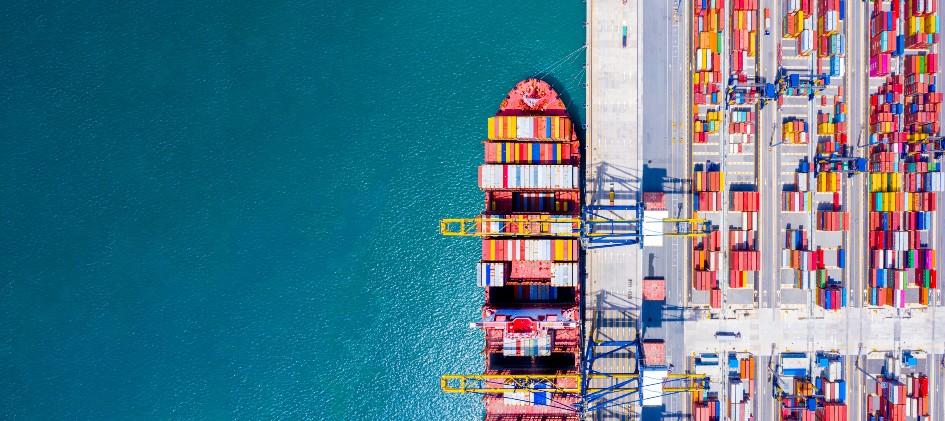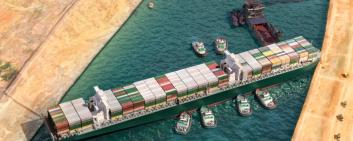Whereas at the beginning of the crisis the difficulties were mainly limited to imports from Asia, today all shipping routes are under pressure: Freight companies struggle with undercapacity, overcrowded ports, congested container terminals and insufficient infrastructure.
Container ships are getting bigger and bigger and can already load up to 23,500 TEUs (Twenty-Foot Equivalent Unit; standard container). When several ships of this dimension arrive at a seaport at the same time, it causes major logistical problems – even in "normal" times. The ports of Singapore and Los Angeles/Long Beach, for example, are often heavily congested due to the large volume of containers. Singapore is immensely important as a hub for the Southeast Asian and Australian markets, while the two ports on California's south coast handle around 40 per cent of US sea freight and are crucial for transpacific traffic. It's no wonder then that the timeliness of ships is at an all-time low: Whereas 65 per cent of ships worldwide arrived on schedule in spring 2020, less than 35 per cent did so one year later. Delays of up to six weeks – on the route to China, for example – are unfortunately no longer uncommon.
Pandemic-related outages
Due to the coronavirus pandemic, some very important shipping terminals have been out of service several times over the past few months. And there doesn't appear to be any change on the horizon with regard to this situation: Around two weeks ago one of the largest port facilities in the world, Yantian in the city of Shenzhen in Southern China, was closed at short notice due to the registration of new Covid-19 infections. Many container ships had to be diverted, which resulted in delays of up to 14 days for imports and exports. Countries like India, Pakistan and Bangladesh are currently in a partial lockdown: Although the ports are open, there is a lack of staff in the terminals. The situation is also worsening for the companies responsible for road transport, because many truck drivers are unavailable. There was also bad news from Southeast Asia again this week with rising infection figures in Malaysia and Vietnam.
Systemic deficiencies
The Corona pandemic has not only caused acute problems in sea freight, however; it has also brought to light a whole series of systemic failings. One of the biggest challenges is the lack of container equipment and shipping space. In April 2020, 551 ships with a capacity of around 3 million TEU were decommissioned. Once the shipowners put these ships back into service, the corresponding capacities were available to the market again in the fourth quarter of last year. However, because almost all companies around the globe are expanding their stock levels – and because consumption has already picked up strongly again – demand far exceeds the availability of shipping space, meaning waiting times of four to five weeks are often inevitable. The major shipping routes to the USA and Asia are particularly affected by these delays. The situation was further aggravated by the blockade of the Suez Canal, which led to delivery delays of 20 days or more, and the "Ever Given" owned by shipping company Evergreen is still out of service after being seized by the Egyptian authorities, so the 20,000 TEUs of this ship are unavailable for imports and exports.
Rising prices
In the short and medium term, not much will change in terms of capacity – which is why the shipping companies are shying away from making clear forecasts. The fact is that shipowners are handling the available space better today than ever before. And it is also clear that additional containers or more ships would further strain the already precarious infrastructure of many ports. It is therefore not surprising that freight rates have climbed to new highs on all shipping routes. Meanwhile, prices will continue to rise sharply: For sea freight to the USA and South America in particular, massive increases should be expected in July.
Cautious outlook
The problems mentioned above will continue to hamper international sea freight traffic for some time to come. Experts agree that the situation will not change before the end of the year and may even remain until after the Chinese New Year (February 1, 2022). There are many reasons for this less than optimistic outlook:
- Q3 and Q4 are considered the strongest quarters of the year in retail, and fast approaching is not only is Golden Week in China (October 1 to 7, 2021) but also the year-end spurt (imports and exports for 2021 Christmas business have already begun).
- Consumer sentiment is already very good again in the USA and Asia, and it is also picking up in Europe.
- The economic stimulus programs launched by various countries will tie up large transport capacities.
- The existing overflow of containers to be transported must be reduced in the coming months before conditions can return to normal.
There is justified hope that, as the vaccination programs move forward in the individual countries, the situation on the labor market will also ease. As soon as dock workers and truck drivers can resume their work and carry it out without any major restrictions, the market will gradually return to normality. Prices for sea freight will, however, remain at a high level.
Possible alternatives
Although the Northeast Passage is navigable between June and December, it is not generally used by international sea freight traffic – with very few exceptions. The main reasons for this are a lack of safety (shallow draft!) and the lack of infrastructure along the route, but primarily it relates to issues of a political and environmental nature. A valid alternative would be rail transport from Asia to Europe – but here, too, capacities are fully booked for weeks. What's more, prices in this segment quickly adjust in line with those of sea freight. Because overseas passenger flights are still rare at the moment, there is also a lack of capacity when it comes to air freight – although an increasing number of cargo aircraft are being used. While prices for air freight to Asia have more or less settled at pre-Corona levels, rates for shipments to the USA or South America are now around three times higher than before the pandemic.
Key recommendations
- Talk to your customers and suppliers: This will enable you to organize your transport needs in good time.
- Plan for significantly longer lead times: Short-term bookings are practically impossible nowadays or a matter of pure luck.
- Talk to your hauler in good time: Good forecasts will help them to book the required space in time.
- Check the possible options: Your shipments don’t always have to go via the northern ports – the southern ports are a good alternative.
About Claudio Licci
Claudio Licci has been working for Lamprecht Transport since 1982. Today, he is a member of the executive committee with responsibility for the sea freight of Lamprecht Transport. After an apprenticeship and time spent abroad, he completed his training as a forwarding specialist and graduated with an economics degree from a university of applied sciences in 2001.







